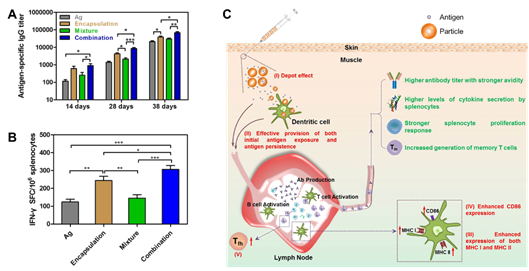Vaccination plays an important role in preventing infectious diseases, and saves more than 3 million people every year. Concerning the safety profiles and side effects, subunit vaccines based on protein antigens are usually better tolerated and regarded as safer alternatives to traditional vaccines based on attenuated or inactivated pathogens. Subunit vaccines are usually poorly immunogenic when used alone and therefore require exogenous adjuvants to augment resultant immune responses. Nano/microparticles are promising adjuvant for subunit vaccines. Many physicochemical characteristics significantly influence the adjuvant effect of micro/nanoparticles; one critical factor is the kinetics of antigen exposure to the immune system by particle-adjuvanted vaccines.
Recently, the research team led by Prof. MA Guanghui at Institute of Process Engineering, Chinese Academy of Sciences, investigated the effect of antigen-nanoparticles formulation patterns on the kinetics of antigen exposure to the immune system and the efficacy of nanoparticles-adjuvanted vaccine. They found that the nanovaccine efficacy was significantly improved by combining antigen-nanoparticles mixture formulation and nanoparticles-encapsulated antigen formulation.
Their findings demonstrated that the combined vaccine formulation (antigen encapsulated within nanoparticles + soluble antigen mixed with blank nanoparticles) elicited more potent antigen-specific immune responses than single-component nanoparticle-adjuvanted formulations (antigen encapsulated within nanoparticles, or soluble antigen mixed with blank nanoparticles). The enhanced immune responses elicited by the combined vaccine formulation might be attributed to the antigen-depot effect at the injection site, effective provision of both adequate initial antigen exposure and long-term antigen persistence, and efficient induction of DC activation and follicular helper T cell differentiation in draining lymph nodes. This work might have significant implications for rational vaccine design.
This work was supported by the 973 Program (Grant No. 2013CB531500), the Special Fund for Agro-scientific Research in the Public Interest (Grant No. 201303046), and the 863 Program (Grant No. 2012AA02A406). The results have been published on Biomaterials 2014, 35 (23): 6086-6097.

A. Antigen-specific IgG antibody titer in sera; B. Frequency of IFN-γ–secreting cells in splenocytes analyzed by ELISpot;
C. Schematic illustration of the proposed mode of action of the combined vaccine formulation (Image by IPE)
 Search
Search




 京公网安备110402500047号
京公网安备110402500047号